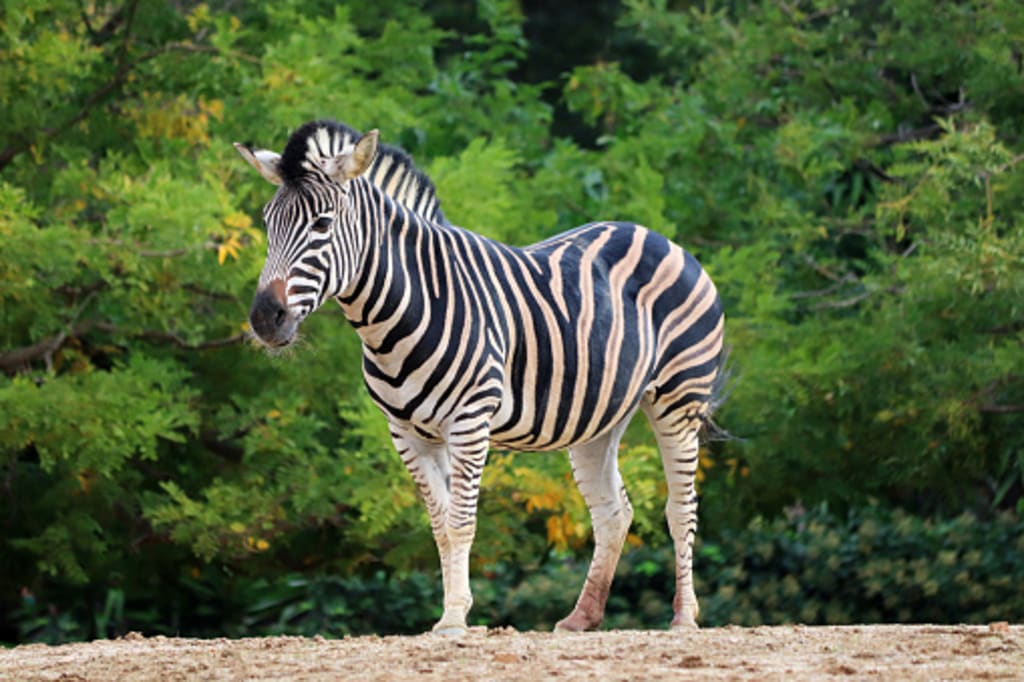The Life and Habits of a Zebra
"Striped Wonders: Exploring the Fascinating Life and Habits of Zebras"

With their black and white stripes, zebras are among the most recognizable and beloved African animals. This equation has captivated the world with its unique appearance and interesting behavior. In this article, we look at the life and behavior of zebras, their social structure, eating habits, migration, and survival strategies.
Physical characteristics:
Zebras belong to the Equidae family, along with horses and donkeys. It is characterized by a black-and-white striped coat that varies in pattern and intensity among different zebra species. These stripes are a form of camouflage, making it difficult for predators such as lions and hyenas to spot individuals in a herd.
Community Structure:
Zebras are highly social animals, usually living in small family groups called harems. A typical harem consists of a dominant male, known as a stallion, several females, and their offspring. This social structure helps provide protection and increase the chances of survival for the group as a whole. The main herd plays an important role in protecting the herd from predators and other males who try to challenge its reputation.
Eating skills:
Zebra is a herbivore, eating mainly on grass and occasionally browsing on leaves, bark, and twigs. It has large, sharp teeth with a special set allowing it to eat coarse grass. Zebras are also adapted to their habitat, where they can extract nutrients from tough plants that other plants may have trouble eating. The digestive system allows them to efficiently remove moisture from the food they eat and survive in dry areas.
Migration and water dependence:
In search of food and water, zebras make seasonal migrations, often covering long distances. This migration pattern mainly affects the availability of water and the movement of other plants. Zebras are known to form temporary associations with wild animals and other grazers such as ants, as they share migration routes and rely on each other for protection from predators. This cooperation increases the chances of survival for all species.
Communication and vocalization:
Zebras have a variety of vocalizations and body language that facilitate communication in the herd. They use various sounds such as grunts, barks, and whistles to communicate different messages to other members of the group. In addition, zebras rely on visual cues such as facial expressions, ear positions, and tail movements to communicate their intentions and emotions.
Avoidance and defense mechanisms of triggers:
Zebras use several strategies to avoid predators and protect themselves. The distinctive black and white stripes are a form of visual confusion, making it difficult for predators to identify individual zebras in a herd. In addition, zebras run fast and can reach 40 kilometers per hour (64 kilometers per hour), allowing them to escape from predators with impressive movements and movements. They also exhibit a behavior known as mobbing, when they gather and confront their prey, using strong blows to ward off threats.
Conservation status and danger:
A number of zebra species are now endangered. Loss of habitat due to human encroachment, competition with livestock for grazing, and illegal hunting pose a significant challenge to their survival. Conservation efforts, such as the creation of protected areas and anti-poaching measures, are essential to ensure the long-term survival of zebra populations.
In summary, zebras are amazing creatures with amazing adaptations that allow them to thrive in their African habitat. From social dynamics and feeding habits to migration patterns and defense mechanisms his life is closely related to his existence as a species. The social structure of harems, special pastures, and communication and cooperation with other herders contribute to their success.
Due to the availability of food and water, the migratory behavior of Zebras shows their adaptability and endurance in harsh environments. This seasonal movement not only ensures their survival, but also strengthens the interconnectedness of the ecosystem, creating a symbiotic relationship with other plants.
Zebra communication techniques, including vocalizations and visual displays, play an important role in maintaining social cohesion and preventing potential conflicts within the herd. This effective communication allows them to respond quickly to threats and coordinate their actions for the benefit of the entire team.
Their defense mechanisms, such as their speed, agility and strong kicks, help zebras avoid predators and reduce the risk of predation. The black and white stripes are an evolutionary advantage that confuses and confuses predators, allowing zebras to join larger herds, making it difficult for predators to identify them.
Despite their remarkable adaptations and survival strategies, zebras face significant conservation challenges. Habitat loss due to human activities, including agriculture and urbanization, destroys natural habitats and disrupts migration patterns. Competition with cattle for limited pastures puts further pressure on the zebra population.
Illegal hunting and poaching harm the demand for zebra skin, meat, and body parts. Efforts to protect the future, such as creating protected areas, implementing anti-poaching measures, and raising awareness of the importance of habitat protection, are essential.
In summary, the life and behavior of zebras are a testament to their extraordinary adaptations and survival strategies. Every aspect of its existence, from social dynamics and eating habits to migration patterns and defense mechanisms, is perfectly tailored to its unique niche. Understanding and appreciating these amazing creatures not only enriches our knowledge but also inspires us to protect and preserve their fragile existence for future generations.





Comments
There are no comments for this story
Be the first to respond and start the conversation.